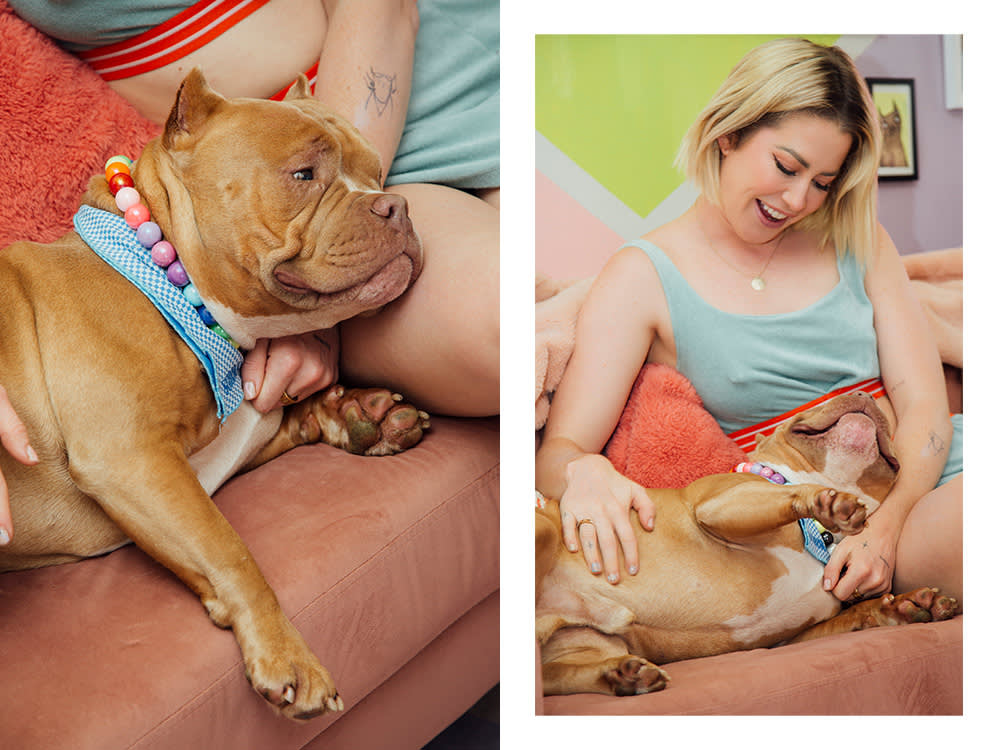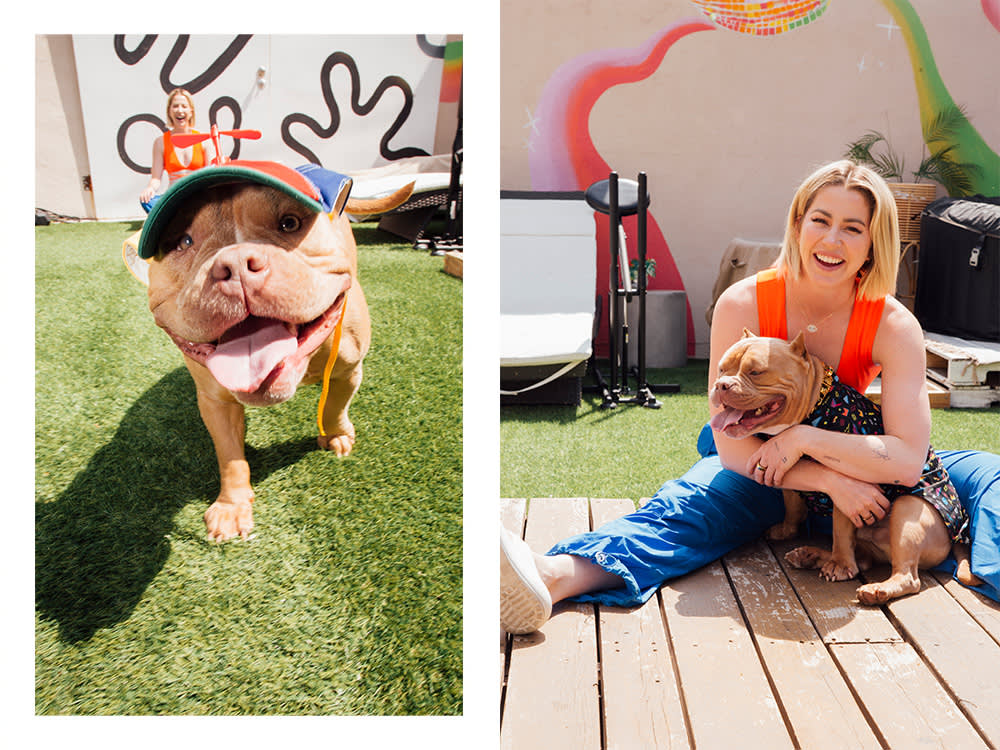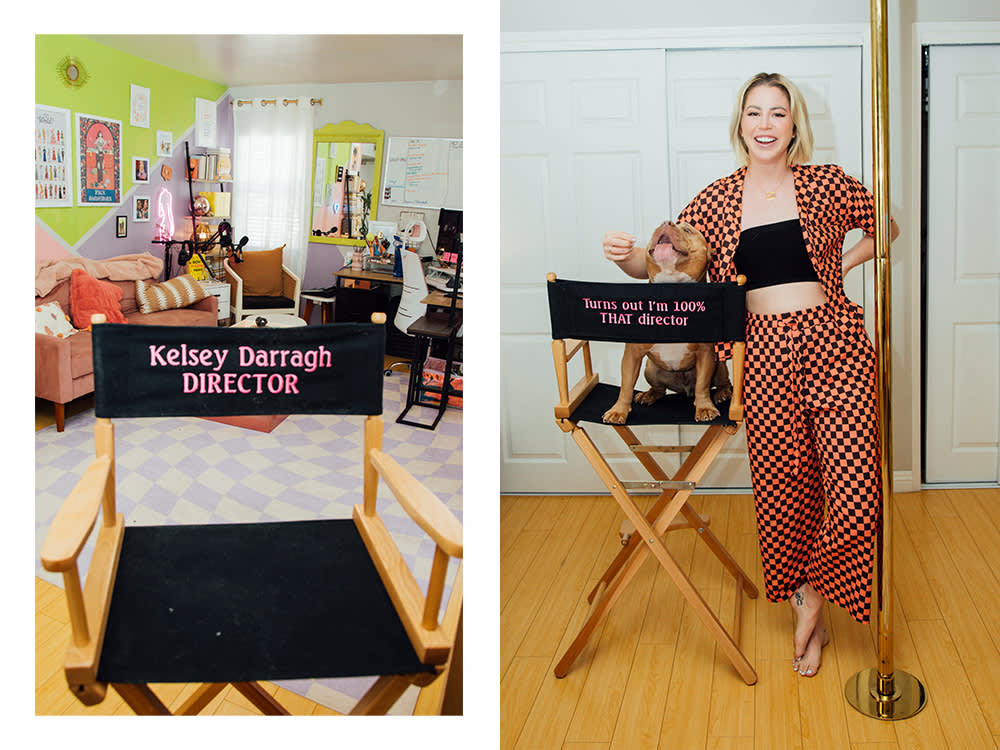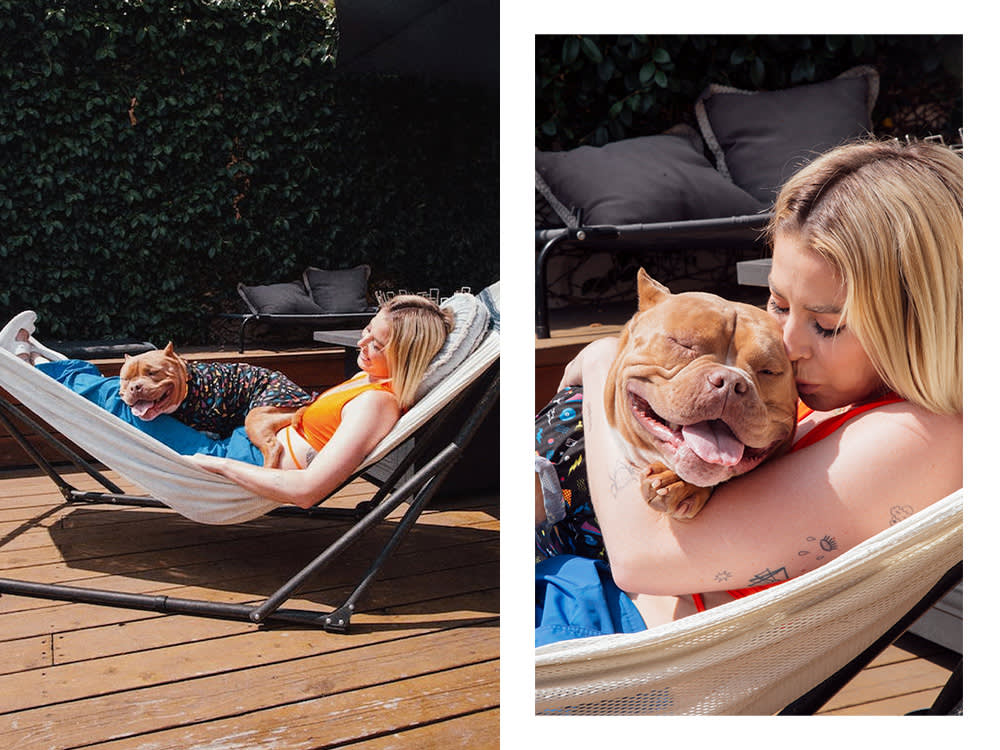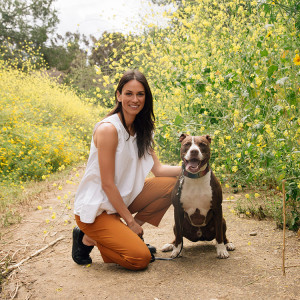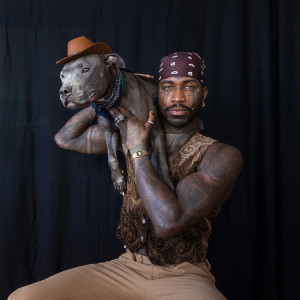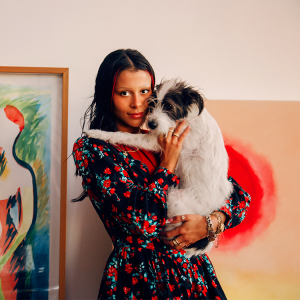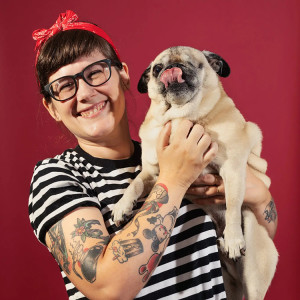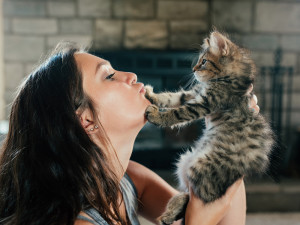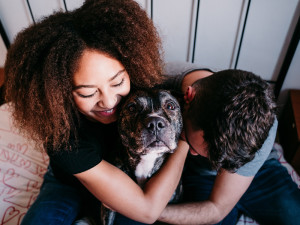Kelsey Darragh’s Pit Bull, Hippo, Is Her True Soulmate
The filmmaker, comedian, and mental health advocate’s boyfriend didn’t want to adopt their foster pup. She ditched the guy and kept the dog.
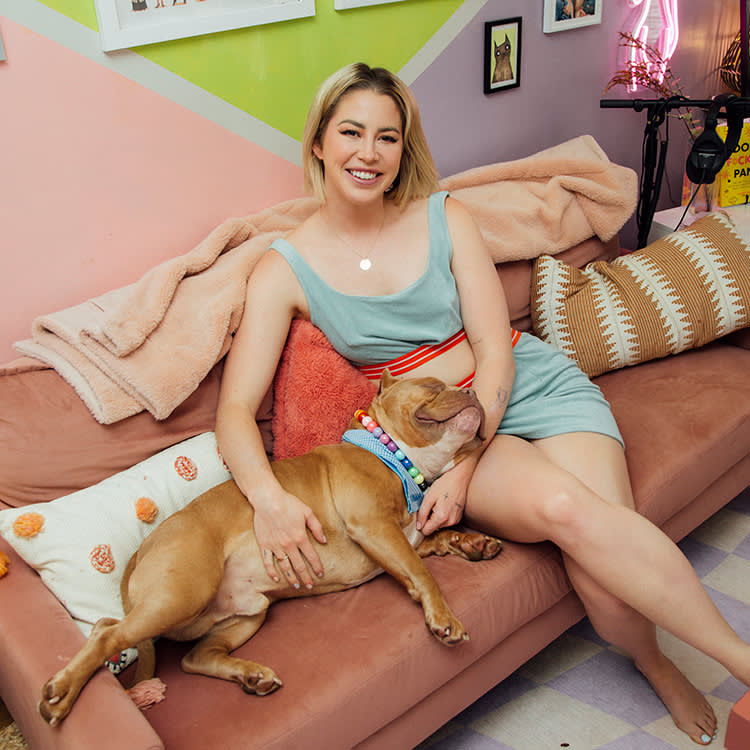
Share Article
For nearly a decade, Kelsey Darraghopens in new tab has lived her life on the internet. The 32-year-old multi-hyphenate was the talent behind the scenes and in front of the camera of hundreds of BuzzFeed videos during her tenure there, humorously exploring the milieu of the millennial. Since then, Darragh has become an outspoken opens in new tab and transparent advocate for mental health — using her BuzzFeed base and video skills to serve as a voice for mental health advocacy. This led to her 2020 book, Don’t F*cking Panic: The Sh*t They Don’t Tell You in Therapy About Anxiety Disorder, Panic Attacks, & Depression.
And that’s just the beginning for Darragh, who is stepping into a new chapter of her career. While she’s still doing what she’s been known for on TikTokopens in new tab and Twitteropens in new tab, she’s been co-hosting the podcast Confidently Insecureopens in new tab, and she’s now directing more documentary-style projects. Clearly not one to not keep busy, she’s currently working on a book about living with chronic pain.
Hippo was one of the many fosters who Darragh has helped over the 16 years she’s been fostering and was her first foster failure. His gentle nature drew Darragh to him and inspired her to write her first children’s book called Positively Polite: Being a Petting Pal, which teaches children how to ask before they pet a dog they don’t know. Kinship talks with Darragh about her history fostering animals, mental health, and finding her soulmate in Hippo.
You’ve had a really long history of being passionate about fostering. How did that become something that you started doing pretty consistently?
I grew up in a family of animal lovers. My dad was always the guy who would stop on the side of the road to move a turtle out of the way. He was in the horse business, so I grew up going to horse camp. I was always just a huge animal lover. When I went to college in Alabama, I was really struggling with anxiety and social anxiety. And so to get myself out of the house, I started volunteering at a shelter. And I noticed down in the South, always, Pit Bulls were being dropped off. When there would be a batch of Pit Bull puppies, I would always be like, “I’ll foster one. I’ll foster one.”
How much do you spend on your pet per year?

So, when I first moved out to LA within the first six months of living here, I worked at a kill shelter for two months and ended up with two cats. I stopped volunteering in the shelter as much, and I started fostering.
You are very transparent about your struggles with mental health. How has fostering helped your mental health?
I wrote about my first LA foster in my book.opens in new tab His name was Barry. He came from the North Central Shelteropens in new tab in Los Angeles, before they renovated it; it was the hardest shelter in Los Angeles. And he just brought me so many lessons in life that I didn’t know could be learned through an animal or fostering. This idea of giving to something that’s not yourself, establishing a routine...in mental health that’s so important.
A dog was more of a daily responsibility. So, just getting a routine in my life changed my mental health. Having to socialize him made me socialize more with people. And when you’re fostering, you want them to get adopted, so you have to talk to people. For someone that was living with major agoraphobia for a little while, a huge part of my healing was just having a reason to do that. You have to go outside. You have to get that vitamin D. You have to interact with humans. And I was always a cat person my whole life until I really started fostering dogs more seriously.
Obviously, there’s a difference between fostering and then having your own pet. So, how did you end up foster-failing with Hippo?
I had done about nine animals in LA, fostering between cats and dogs, before Hippo. And during those years I was in a solid place in my life, and it just felt like a system. I knew I was bringing a dog in. I knew I was bringing a dog out. When I got Hippo, I was going through one of the hardest times in my life. My mental health was shit. My five-year relationship was going through the hardest time. I had experienced a crazy trauma the year before with a break-in at my house. And things were really unsettled even though I was projecting on social media, like, “I’m living the life.”
And Hippo was a f*cking mess. He had insane health issues, very expensive, very time-consuming. And we both started to heal together…that was not the plan. The plan was to put him on social media like I always do, and use that as a way to get people interested. And people were very interested in him from the first day I posted the videoopens in new tab. I was in such denial that he chose me, but I think in that moment he was like, “You’re my mom. I’ll wait for you to come see it.”
How long did it take for him to recover from his health issues?
It ended up being at least two months of him healing. He had to have eye surgery. He had to be fixed. He had the worst skin infections. My ex, who was my boyfriend at the time, was like, “We can’t have a dog. We travel too much.” And then I’m going, “I think I want to keep the dogopens in new tab and get rid of the guy.” There was a guy [who was interested in adopting him]. I was sitting at the boba shop with Hippo, and the guy said, “Hey, I’d love to come meet him, and if I like him, I’ll take him tonight.” And in that moment, I just lost my fucking sh*t. I was like, “I can’t let go of this dog. We’ve been through hell.” I called the rescue, a lovely woman named Alex, who knew. She said, “Kelsey, we told you from the moment that first video we saw of him home, that was your dog.”
How have you and Hippo helped each other with your mental health?
It’s impossible to be sad around him. Even if I’m going through something, he brings a sense of mindfulness that brings me to the present every time I look at him. He takes me out of my head. I just feel so lucky — every time I come home, it’s like the first time. I think he’s just a lot happier. I truly believe dogs know when you’re trying to help them.
He does have chronic health problems. So, even though every day I have to give him three eye drops, three times a day, he knows that I’m there, so he’ll just sit right there. He’ll let me poke his eye. Without a doubt, I know Hippo is deserving of love and completely lovable, even despite all of his stuff. And it helped me realize, “Oh, I am still deserving of love and deserving of health. I am lovable despite all of these struggles with health.”
We are coming up on Pride Month, following Mental Health Awareness Month. You are openly bisexual. What was the coming out process like for you, and how did you process it?
It’s funny you ask because I’m writing a guide on bisexuality as we speak! I grew up going to church three times a week, but it was mainly something to do so we wouldn’t get in trouble according to my parents. It was drilled into me that homosexuality was wrong, but every time I went to a friend’s sleepover and made out with my friends to “practice kissing,” it felt really good! I came out to my friends before my parents who pretty [much] knew that when I started bringing over certain girl pals...they weren’t just pals.
I was very lucky to never be shamed for my identity or told it was wrong by anyone close to me. I had to get over the fear of the wrath of the church on my own, which brought me a lot of anxiety. Once I realized that no one from my community really gave a sh*t that I liked women, too, it was that battle with my own mind — the unlearning that it was OK to be who I was! And fully accept that!
Why is important to you to talk about being bisexual and using your platform to do so?
There is so much bi erasureopens in new tab! I still can’t name 10 famous bisexuals off the top of my head. It’s so much more common than we think and its a large part of what makes the LGBTQ+ community so great! We are such a silent majority, so I try to be as loud as I can about it to let people know there is a space for us.
Speaking of breaking down stigma, Pit Bulls have long had a bad rap. How have you seen public opinion change about them since you first started fostering the breed?
It’s very funny, because I see it on TikTok all the time, where if you ask a vet what dog they’re most afraid of to treat, they’ll say a Chihuahua. It’s thanks to social media that we’ve been able to see these stories and access to bully breeds that show such a positive side. Because now whenever I meet someone in public, and they’ll say, “I don’t know why these dogs get a bad rap. They’re so sweet.” Just spreading that education of, “It’s not the breed. It’s the owner. It’s the environment.” Really, it’s just about education.
What does the fostering scene look like in Los Angeles right now?
LA is always in desperate need of fosters. I always tell people that people don’t know. They always are like, “I could never foster. I’d always get so attached,” or “I don’t have the time or money.” And I always say, “It’s so important to know that rescues pay for everything, including food, medical. A dime does not come out of your pocket or you are reimbursed always.” These shelters or rescues work with shelters all over Los Angeles, even to the point where if you see a dog you want to pull and foster, they will normally advocate for that dog. I always also say that, “Even a day out of the shelter is better than nothing.”
What are some of your favorite organizations to work with?
I really like to work with the LA City Shelteropens in new tab, so there’s probably 10 shelters that work under that. And the rescue I love to promote is I Stand With My Packopens in new tab, which is where Hippo came from. They often pull breeds that no one else will pull. They pull the problem dogs. They pull the ugly dogs. They pull the medical case dogs. And then, of course, Canine Rescue Clubopens in new tab, they are pulling dogs that have acid thrown on them from the street or the dogs from Mexico that need to be flown in. They really put their money where their mouth is, and they don’t breed discriminate. Road Dogsopens in new tab is another great rescue. They do mostly bully breeds and Frenchies.
What is your advice to someone looking to eventually find a Hippo in their life but want to start slow before fostering or adopting?
I would always just say [to] go out to your local shelter and do a training course. It’s usually half a day of going around and learning how to properly let a dog go out or how to fill the bowls for enrichment activities, but make it a fun thing. I’ve gone on dates to volunteer before. I’ve done class trips with people or family. Or if you’re active and you go for runs, take a shelter dog with you in the morning, go for a run, go pick up a dog and go run or hike. So there’s many ways and styles of being involved in the rescue community. It doesn’t necessarily mean you’re married to the idea of fostering a dog for three months. There’s so many different ways that you can help out.

Kerensa Cadenas
Kerensa Cadenas is a writer based in New York City. She’s previously worked at The Cut, Thrillist, Cosmopolitan, and Complex. Her work has been featured in Vulture, GQ, Vanity Fair, and others.
Related articles
![Asha Leo walks with her psychiatric service dog, Pirate, on a trail]()
Pirate the Pit Bull Is Asha Leo’s “Person”
How the Pit Bull advocate is bolstered by her Instagram-famous psychiatric support dog.
![Yves, a man with a lot of tattoos and a brown paisley head bandana in tan pants holding his grey Pitbull dog who is wearing a tiny cowboy hat over his shoulder]()
The Misunderstood Pit Bull Is at the Top of Yves’s Advocacy List
The model, activist, and musician on his activism philosophy: “I’ve always been drawn to those who have been left behind, forgotten, misunderstood. I relate to them on a very deep, personal level. No matter how different you are, everyone deserves a chance.”
![]()
Sami Miró’s “Super-Mutt” Sunnie Helps Her Find Her Center
Especially when the eco-forward fashion designer has red carpet nerves.
![Gemma Correll smiling and holding up her one-eyed Pug dog against a red backdrop]()
Gemma Correll Talks Pug Life and Mental Health
How the illustrator’s rescue dogs improve her psychological well-being. (Spoiler: Pugs make pretty great weighted blankets.)
![A brunette woman holding a spotted gray kitten up to her face while its front paws rest on her chin]()
10 Foster-Fail Stories That Will Tempt You to Do the Same
Adopting a foster pet doesn’t isn’t always the right choice. But for these families, it turned out to be the only one.
![Couple hugging their Pit Bull]()
What Is a Pit Bull, Exactly?
Everything you need to know about the five breeds dubbed “Pit Bulls.”
